Company Growth, Mod Progress, Electronics Changes, Other Projects and Updates

August 10, 2010 notes by Ben Brockert:
Company
Armadillo is now seven full time employees. Most of the core group is now full-time, with Neil Milburn as the most recent addition, finishing his last year of teaching high school in June. In late May at ISDC John said,
"I think one of the best things about having the other companies in the industry is that it's developed some very skilled and talented people, and we're probably going to steal some of them." Subsequently, I, Ben Brockert, joined the company in late June, having previously worked on VTVL rockets at Masten Space Systems.
John Carmack and Matt Ross both continue their work at id Software, and contribute to AA in their copious free time. Mike Vinther is a pilot and a skydiver who has been working with the Rocket Racing League, and has been also helping us with rocket ops and parachute work.
As noted in that same talk at ISDC, Space Adventures is working with Armadillo Aerospace to begin developing a new suborbital vehicle. You can read that press release here. It's a great project to be working on, exactly in line with Armadillo's goal of regularly flying people on suborbital flights.
Mods
We've done a few flights on the mods with different configurations of drogue parachutes for engine-off stability. In the long term, parachutes aren't the way to go; they're surprisingly heavy, failure prone, and it is near impossible to model the behavior of the parachute-rocket vehicle system. But for now they enable envelope-widening flights and engine-off tests we couldn't do otherwise. We're also looking at adding a large recovery chute to the mod, to enable a last means of recovering the vehicle when we've pushed the envelope too far.
First engine-out flight; drogue attached to single point
Second engine-out flight; drogue attached to four points this time
We're currently building a mod with a first pass aeroshell, consisting of cylinders and frusto-conical sections of aluminum sheet. This will enable us to start exploring the behavior of the rocket under higher velocity flight, where aerodynamic loads start to matter. For easiest control in powered flight, the center of gravity (CG) would be above the center of pressure (CP), but for the falling portion of the flight we want the CG slightly below the CP, so that it falls in a near flat, base-first configuration. With aerodynamic analysis and some test flights, we'll work toward finding the ideal balance.

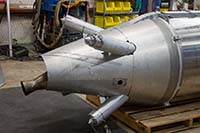

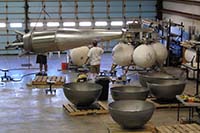
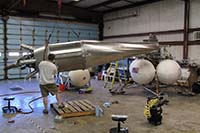
We put a new landing gear concept on that mod, and have been testing it in the shop. It is a series of concentric tubes, making the legs pneumatic pistons. This first pass is rather heavy, made from off the shelf tubing, but also quite sturdy and effective. They are deployed using ullage gas from the fuel tank, and behave quite well even when depressurized with the vehicle sitting on them.
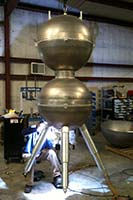
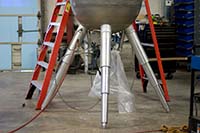
This mod will be on display at QuakeCon this week. John's keynote will be at 2:30 on Thursday the 12th, followed by a "Rocket Talk" with John and private astronaut and game designer Richard Garriott at 5:30. More information is available on the QuakeCon website.
Electronics
We just put together another electronics box, the design has really stabilized after going through a number of iterations. It is shared between the mods, Pixel, and the horizontal test stand, as well as a version without GPS and IMU on the rocket racers. One coming change is that we're looking at switching from brushed DC actuators to brushless motors; the driver electronics are more complex, but the motors themselves have much better power to weight and are more compatible with operation in vacuum.
In IMUs, we are considering switching to KVH, mostly because Crossbow's delivery schedule has gotten incredibly bad. The relevant factors:
- KVH is a few thousand dollars more -- $15k, vs $12k.
- KVH updates at a lower rate, 100 hz vs. 165 hz.
- The KVH is a bit more bulky, and weighs a pound or two more.
- The accelerometer output appears pretty much identical.
- The KVH gyros appear to have about half the noise.
- The KVH gyros are rated for 350 deg/sec, vs 200 for crossbow. We came uncomfortably close to pegging the Crossbow on the drogue flights.
- The KVH has a better serial line protocol, and starts up spewing data without requiring initialization.
- The KVH supports rs485 as well as rs232.
- The KVH gyros have good biases out-of-the-box, without requiring a bias zeroing step.
We will hopefully have some flight data on the KVH option later this month.
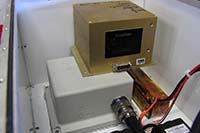
Other Projects
Last week James completed the welding of our first 48" 5059 spherical tank, which has been sent off for burst testing. The current mods and quad use 36" diameter tanks, so this is quite an upsize. The previous tanks were also alloy 5383. The newer 5059 alloy was developed in Europe for high performance aluminum yachts. It is very corrosion resistant, and has a significantly higher strength in the as-welded condition, which will increase the pressure rating for the same thickness of tank.
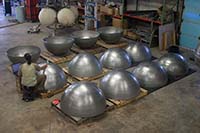

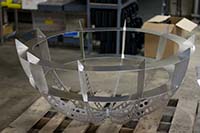
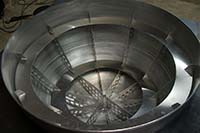
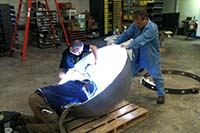
This 48" tank project is part of our work with Nasa. We had a very fruitful visit from expert industrial technologist Daniel Rybicki, who is a contractor for Nasa. He has a number of patents and papers to his name, and contributed a lot of interesting concepts on how we could continue to improve our tank manufacturing practices. It's been great to have access to people with practical knowledge on the problems we're working on.
He and James evaluated new processes for really thorough weld prep, as well as trying a couple of completely different welding techniques on some test coupons. We're looking froward to getting data back from those tests, and finding out what the best process is for manufacturing our rocket propellant tanks.
Other Updates
Armadillo can also be kept up with through our official YouTube channel and Facebook page, as well as official forum. John also recently joined Twitter as ID_AA_Carmack, I am wikkit, and Russ and Phil have neglected accounts as rpblink and ArmadilloGadget, respectively.
|